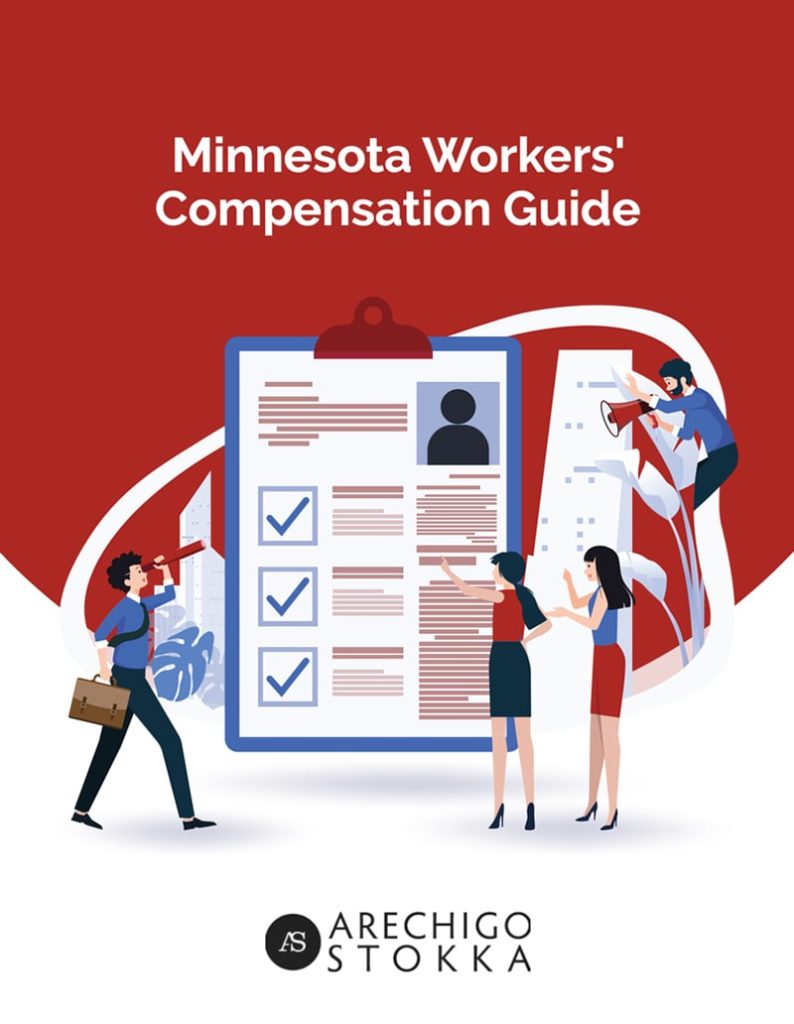Summary of Minnesota’s Workers’ Compensation System
Before the establishment of laws to protect employees in the workplace, a worker who suffered from a job-related injury or illness was forced to file a personal injury lawsuit to recover compensation for losses.
The litigation process is costly and time-consuming and requires proof of employer fault. These burdens put employees in a difficult financial situation.
Like other US states, Minnesota implemented a workers’ compensation system that provides monetary benefits to employees suffering from a work-related medical condition.
One of the requirements of the law is that all employers in the state carry workers’ compensation insurance for the benefit of full- or part-time employees.
A qualifying worker with a work-related injury or illness can receive benefits by notifying the employer and insurance company.
The Minnesota workers’ compensation system offers multiple advantages:
- By meeting the eligibility requirements described below, you may start receiving benefits shortly after your claim is approved. There’s no need to go through the expensive, drawn-out litigation process.
- You don’t need to prove that your employer was at fault in causing the accident or allowing the workplace conditions that resulted in your injury or illness.
However, there are two important caveats that you should understand about the workers’ compensation laws.
- The system pays out a range of monetary benefits, but you cannot recover compensation for your non-economic damages. You’re not eligible for pain and suffering, emotional distress, or related losses.
- In most cases, workers’ compensation is your sole remedy. You cannot file a civil lawsuit to recover monetary damages. There are some exceptions to this default rule, so you may be able to sue in court if:
- Your employer doesn’t have workers’ compensation insurance as required by law;
- Your injuries were caused by intentional acts; or
- A third party is responsible for your medical condition. Examples might be where you were in a motor vehicle accident while working, you were hurt by defective equipment, or an unrelated entity on the job site caused your ailment.
Recent Workers’ Compensation Case Settlement
Recovery After Our Client Was Denied Coverage
THE FACTS: Mr. M came to our office after suffering a horrific injury in which he had two of his fingers amputated by a lift gate. The employer and insurer denied coverage for the injury alleging that the injured worker was an independent contractor. Because of the denial, there was no coverage for lost wages and his medical bills were mounting.
THE INVESTIGATION: After researching the issue, we determined that under the law he was not an independent contractor.
THE RESULT: The case settled for past and future wage loss, all medical bills paid, and a significant lump sum settlement.
Benefits for Your Lost Wages
One of the key benefits of Minnesota’s workers’ compensation system is wage replacement for the income you lose while you’re recovering and away from work.
Once you miss three days due to an illness or injury, you’re eligible to receive:
- Temporary Partial Disability: In some cases, your medical condition allows you to go back to work, but on a limited basis. If you cannot work as many hours or earn the same income as you did before your ailment, you may qualify for temporary partial disability.
- Temporary Total Disability: When you cannot work at all, or your employer cannot accommodate you in performing job-related tasks, you could be eligible for disability payments on a temporary basis. The amount is two-thirds of your average weekly wage, up to a certain amount designated by law.
- Permanent Partial Disability: If you suffer from an injury or illness that will permanently reduce your income potential, you could receive this type of benefit. Permanent partial disability covers the difference between what you earned before and after the issue that caused your medical condition.
- Permanent Total Disability: In a situation where you can never work again because of a workplace or job conditions, you could qualify for permanent total disability payments. Typically, these benefits cease when you turn 72. If you suffer injury after the age of 67, you can receive permanent total disability benefits for five years. There is a legal presumption in Minnesota that you’re permanently disabled if you:
- Lose permanently and totally the use of both arms at the shoulder, eyes, or legs so close to the hips that no effective artificial members can be used;
- Suffer from permanent, complete paralysis;
- Have a total and permanent mental disability;
- Have at least 17% whole-body permanent partial disability rating and are totally and permanently incapacitated from working to earn income;
- Were at least 50 years old at the time of injury, have a permanent partial disability rating of at least 15% of the whole body, and are totally and permanently incapacitated from working to earn income; or
- Were at least 55 years old at the time of injury, have a least 13% permanent partial disability of the whole body, have not completed grade 12 or obtained a commissioner-of-education-selected high school equivalency certification, and are totally and permanently incapacitated from working to earn income.
Your disability benefits depend not only on the severity of your injuries but also on your average weekly wage. Establishing an accurate average weekly wage is very important to your claim. The greater your average weekly wage, the greater your financial support during injury recovery.
What Is Your Average Weekly Wage?
Minnesota workers’ comp laws calculate your average weekly wage by multiplying your daily wage by the number of days (and fractions of days) you normally worked for your employer. Your daily wage is what you earned daily at the time of your injury. Your daily wage can include the value of board or allowances. Your daily wage cannot include tips and gratuities that you received directly and did not report to your employer. Overtime does not count toward your weekly wage unless it is regular and frequent throughout the year.
If you suffered injuries while performing part-time, irregular, or municipal volunteer work, don’t let the insurance undervalue your claim. The law allows you to maximize your wage benefits by providing different calculations for workers with irregular schedules or jobs.
Part-Time and Irregular Work Schedules
If you worked part-time or irregular hours, you can calculate your daily wage by adding your total earned wages, vacation pay, and holiday pay in 26 weeks before injury and dividing the sum by the amount of days on which you earned those wages and benefits. You can divide by partial days when you worked less than a full day and earned less wages or benefits. If you worked an irregular amount of days per week, the law computes your number of days normally worked per week by adding the days you performed duties for your employer in the 26 weeks before your injury and dividing the sum by the number of weeks you actually worked. If seasonal conditions affect your work hours, your weekly wage cannot be less than five times your daily wage.
State or Municipal Volunteer Work
Municipal volunteers serve an important purpose in our community. These unpaid volunteers still have an average weekly wage for their on-the-job injuries. Volunteer state or municipal workers can still be employees eligible for workers’ compensation benefits if they perform work including:
- Rendering services accepted or contracted for by the commissioner of human services or corrections;
- Engaging in emergency management;
- Participating in a program established by a local social services agency;
- Rendering services accepted by the commissioner of natural resources;
- Rendering building or construction services for joint labor-management nonprofit community service projects;
- Rendering services the director of the Minnesota Historical Society accepts;
- Rendering services (as a non-student) that are accepted or contracted for by the commissioner of education and are performed at the Minnesota State Academy for the Deaf or the Minnesota State Academy for the Blind;
- Rendering services (as a non-resident) accepted or contracted for by the commissioner of veterans affairs at a Minnesota veterans home;
- Rendering attendant services or services as an ambulance driver;
- Rendering services the commissioner of administration accepts at the Department of Administration;
- Rendering services directly to the Pollution Control Agency;
- Rendering certain first responder and law enforcement services under the supervision and authority of a political subdivision;
- Rendering services as a member of the civil air patrol on the request and under the authority of the state or any of its political subdivisions; and
- Responding as a Minnesota Responds Medical Reserve Corps volunteer at the request of or engaged in training conducted by the commissioner of health.
Generally, the daily wages for these volunteers are the usual going wages for the same services performed by paid employees.
Workers with Multiple Jobs
If you worked multiple jobs at the time of injury, all your employment wages are part of your daily wage. You can also seek compensation from all employers liable for your work injury benefits.
While insurance companies seek ways to diminish your wage benefits, Minnesota law gives you opportunities to maximize your wage benefits. Workers’ comp lawyers in Minnesota can identify the best ways to maximize your average weekly wage, and maximize your benefits.
Additional Workers’ Compensation Benefits for Eligible Employees
Besides your lost wages, you may be eligible for other types of payments under Minnesota’s workers’ compensation system.
Your benefits could include medical costs, which cover all current and future amounts related to the treatment of your injury or illness.
This benefit covers a wide range of medical care, including:
- Surgery;
- Hospital costs;
- Treatment by specialists;
- Out-patient procedures;
- Lab exams and screenings;
- Physical therapy;
- Assistive technology, such as crutches, wheelchairs, specialized furniture, and other devices that enable you to carry out daily activities;
- Medications, both prescription and over-the-counter; and
- Any other amounts you incur to treat your work-related medical condition.
In addition, you may qualify for vocational rehabilitation benefits, which pay training, education, and other costs related to making you employable for another position.
Note that the workers’ compensation system also pays out death benefits to the surviving family members of an employee who dies because of an on-the-job injury or illness.
The aftermath of a work injury is time-consuming, draining, and distracting. Generally, you have three years after your employer’s report of injury to seek compensation. Don’t let the insurance company take advantage of your work-injury stress.
Hire a Minnesota workplace injury attorney to meet all important deadlines and fight for what the insurance company owes you.
Speak to a Minnesota Workers’ Compensation Attorney for Free
Lost wages are available to qualifying employees under Minnesota’s workers’ compensation system, but you put your rights in jeopardy if you try to go it alone when filing a claim.
Unless you have a legal background, you may not get the full range of workers’ compensation benefits you’re entitled to by law.
To learn more about seeking lost wages, please contact Criminal Defense Attorney & Workers Compensation Law Offices of Arechigo & Stokka.
You can call 651-222-6603 or complete an online form to schedule a free consultation at our St. Paul office.



